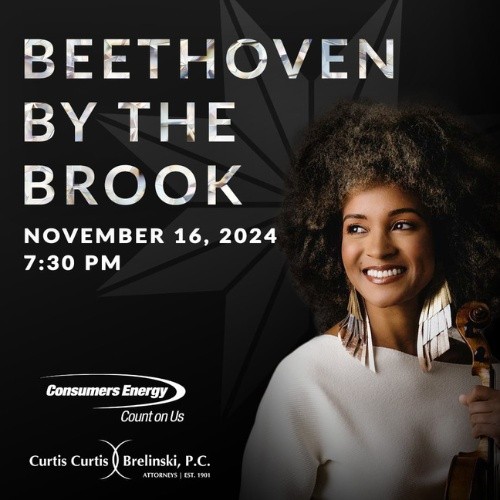

PROGRAM NOTES
November 16, 2024
Beethoven by the Brook
Symphony No.6 in F Major, op. 68 (Pastorale) | Ludwig van Beethoven (1808)
In 1808 Beethoven completed his sixth symphony at a time during which he was enjoying a rising popularity, albeit one without financial security. He already had written some of his most memorable and lasting works, and was a composer fully in possession of technical mastery and supreme musicality—in other words, even if he had composed no more, his place in music history would have been secure. His previous symphony, of course, is now the quintessential model of musical works that exemplify so-called economy of means, integrated technique, unified composition, or any other of a number of terms that simply mean one thing more or less: it’s all about the music—not any experience or object in the physical world. And, of course, that famous composition stems from the skilled manipulation of just a few basic ideas, wonderfully worked out. As we all know from the fifth symphony: “ta-ta-ta-taaah!” This approach to composing became the high altar for the rest of the century for those who reproached music with “stories” or about “real” things.
And then Beethoven did something quite unexpected (being Beethoven): he wrote a symphony about something in our real world of experience! Beethoven openly described his sixth symphony as a reflection of feelings about being in the countryside, replete with birdcalls, a rainstorm, and happy peasants. He nicknamed the work, “Pastoral,” himself, and even precisely noted in the score the names of particular species of birds when he wrote imitations of their calls. However, he was intent that the listener not try to exercise his imagination too specifically, when he cautioned that the symphony was really “. . . more the expression of feelings than painting.” The feelings were good, though, and after the incredible intensity of the fifth symphony, this one is full of serenity, peaceful contentment, and the untroubled enjoyment of nature. Unique in Beethoven’s symphonies, the composer gave each of the five movements (he added an additional one to the more or less standard four) an explanatory title.
But Beethoven being Beethoven, we shouldn’t expect loose formal construction aimed at simply illustrating bucolic scenes with pictorialism driving the cart, like so many composers later in the century—names you know! Rather, in his distinctive and typical fashion he was able to serve both the God of architectural rigor and the Mammon of story telling. That is, we experience the feelings and understand the allusions to birds, storms, and peasants, but all of it is thoroughly shaped by the same principles of tight, logical musical construction that we expect in a more abstract piece like a string quartet, or even a Bach organ fugue. It takes musical skill and inspiration of a high order to pull this off. It’s simply a “perfect classic symphony” that also happens to create a magic evocation of the out doors.
The first movement is notable for its relaxed exploration of clear-cut themes with little of the tension and drive that we have come to associate with the composer. The harmonies stick to relatively close and straightforward relationships, with little exploration of the remote. There are plenty of rustic little tunes to entertain us as Beethoven skillfully explores the description of the feelings that he alluded to in its title. The second movement is clearly one of his great ones, wherein the composer, as did Schubert, conjures up the brook of the title with a constant murmuring string accompaniment. Listen carefully near the end of the movement for the famous passage of the three bird calls: one hears successively quite accurate depictions of a nightingale (flute), a thrush (oboe), and a cuckoo (clarinet). The third movement is the standard scherzo, or dance movement, and here we encounter a country festival with a country band. The middle section of this movement is noteworthy for its duple meter (rather like a march), rather than the usual triple (think of a fast waltz). Listen for a bit of Beethoven’s rough sense of humor in the bass notes of the second bassoon—a real country bandsman! The fourth movement, of course, is the storm, and Beethoven really goes after some degree of realism, here. He adds the piccolo and two trombones for the first time in this symphony, and they help to achieve the thunder, rain, lightning, and wind effects. Some listeners claim there is a rainbow at the end as the storm peacefully fades away. The last movement purports to be a “thanksgiving after the storm,” and is a bright rondo (a repeating theme). One hears a very simple, clear theme-possibly the shepherd’s tune and after a through working out of its possibilities, the movement and the symphony ends with the theme played on a muted horn. One of Beethoven’s sunniest compositions thus ends peacefully, with a rare look into a part of his personality not often seen.
Written by William E. Runyan.
Vltava (The Moldau) | Bedřich Smetana (1874)
Smetana is the first great Czech composer of the nineteenth century, and—owing to the general trend towards nationalism during the late romantic period—the first significant Czech composer to integrate indigenous folk elements into his musical style. He is known the world over for having composed what is more or less the Czech national opera, The Bartered Bride, as well as a wealth of other works. He exerted a significant influence on his younger colleague, Antonín Dvořák, and along with the latter, is honored with his own museum in present-day Prague. The tone poem for orchestra, a distinctive creation of the progressive wing of composers during the nineteenth century, may be said to be the brainchild of Franz Listz, and in 1857 Smetana visited Liszt in Weimar, and took his ideas to heart. The Czechs and Russians really adopted Liszt’s tone poem ideas with much greater alacrity than did his countrymen, and consequently, we have numerous examples by Smetana’s successors: Dvořák, Fibich, Janácek, Novák, Suk and Ostrčil.
Between the years 1874 and 1880 Smetana wrote a cycle of six tone poems, each depicting some important aspect of Czech history or geography. The whole cycle is entitled, Má vlast, or My Fatherland; The Moldau is the second of the six works, and, unfortunately, the only one of them that is regularly heard in this country. Actually, the real title of the “The Moldau” is Vltava, the Czech name for the river, over which spans the bridge in Prague crowded by tourists today. Moldau is the German name for the river, which foreign oppressors used during the long years of Czech domination by German-speaking countries; it was not used by Smetana, nor today by anyone else.
It is easy and pleasing to follow the “story” of this tone poem, for Smetana “painted” the elements in the changing trip down the river most evocatively. Moreover, he left us signposts in his own written notes. The river begins high in the hills as a small mountain stream, heard in the burbling woodwinds and strings. It courses through the forests and meadows, passing along the way a rustic peasant wedding heard through a folk dance. It then moves into darkness, illuminated only by the moon, and we hear mermaids dancing serenely in the night. The famous St. John’s Rapids inspire a stormy passage, with swirling whitewater. The music broadens majestically (with the river) as we approach Prague, and Smetana calls upon the brass to paint the imposing crags of the rocks of Vyšehrad —the magnificent overlook in Prague, home of the mythological origin of the Czech people. Incidentally, both Smetana and Dvořák are buried there in Vyšehrad Cemetery, the resting place of the cultural “heroes” of the Czech people. Finally, the music soars to its emotional heights as the river leaves Prague on its way to the (smaller) Elbe and the sea.
Written by William E. Runyan.
Scottish Fantasy, op. 46 (Schottische Fantasie) | Max Bruch (1880)
Max Bruch (1838–1920) composed Scottish Fantasy for violin and orchestra in 1880, shortly after completing his famous Violin Concerto No. 1 in G minor, a piece that continues to overshadow his other works. Nevertheless, Scottish Fantasy stands as a remarkable composition in its own right, drawing from traditional Scottish folk tunes while blending Bruch’s lyrical style with the energy and flavor of Scottish music. Although Bruch never visited Scotland, he was inspired by the country’s history and culture, especially its folk songs, which he discovered through George Thomson’s collections of Scottish melodies. Bruch admired these melodies for their simplicity, emotional depth, and connection to the Scottish people, often describing the work as his way of paying homage to the beauty and tradition of the Highlands.
The piece is structured in four movements, each based on a Scottish folk tune. The opening movement, Introduction: Grave, sets a grand and solemn tone using the theme “Through the Wood Laddie.” This is followed by the lively Allegro, which features the energetic tune “The Dusty Miller,” capturing the spirit of a Scottish dance. The third movement, Andante sostenuto, is a lyrical meditation built on the beloved ballad “I’m A’ Doun for Lack o’ Johnnie,” conveying a deep sense of longing and nostalgia. The work concludes with the triumphant Allegro guerriero, incorporating the rousing march “Scots Wha Hae,” a theme often associated with Robert Burns’ poem about Scottish independence.
Bruch’s Scottish Fantasy is neither a traditional violin concerto nor a typical fantasy, but rather occupies a unique place in the violin repertoire. It showcases the violinist’s virtuosity while maintaining a deeply expressive quality, balancing Bruch’s romantic sensibilities with the rhythmic vitality of Scottish folk music. Despite its folk origins, Bruch’s treatment of the material is entirely symphonic, crafting a narrative that flows seamlessly between moments of introspection and exuberance. The work remains a favorite among violinists for its emotional depth and the opportunity to connect with the audience through familiar, evocative melodies presented in a grand orchestral setting.
PROGRAM SCHEDULE
Ludwig van Beethoven
Symphony No.6, op. 68, F major (Pastorale) (1808)
Bedřich Smetana
Vltava (The Moldau) (1874)
Max Bruch
Scottish Fantasy, op. 46 (Schottische Fantasie) (1880)
| RUNTIME: 1H 45M |
